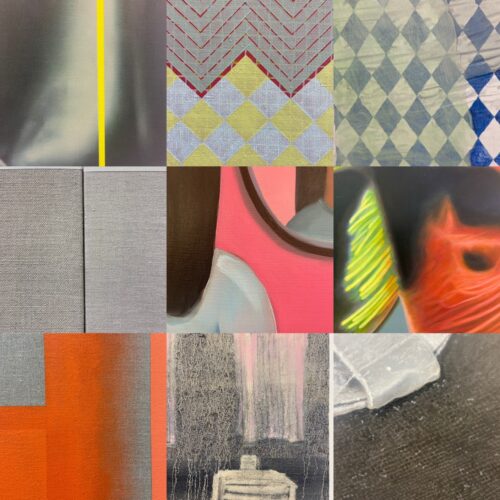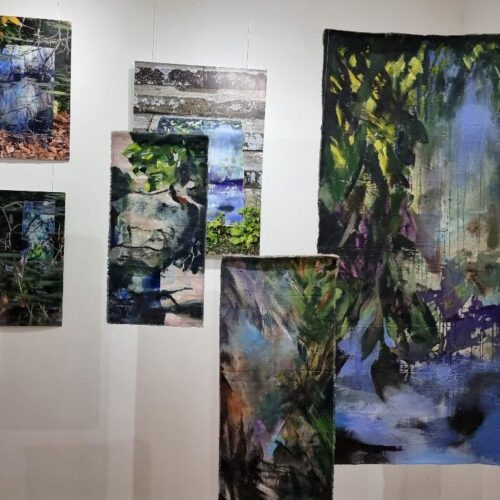
Too Spontaneous?
Last Saturday, students from a range of courses, Drawing, Painting, Sculpture and MA Fine Art, visited the Marlene Dumas retrospective, The Image as Burden, at TATE Modern. This is a large exhibition tracing her work from 1972 to the present. It includes her early conceptual explorations that are a surprise given how consistent she has been in her painting approach for the last 30 years.
The most recent work on show is an on-going collection of heads, Rejects, 1994-2014, a series of ink and graphite ‘portrait heads’ displayed in a grid. Like the Black Drawings 1991-1992, this piece plays with homogenising faces at the same time as inviting you to identify individuals. It is especially poignant when thinking about regimes that have strategically grouped people together in order to accept or reject them. The drawings appear simply rendered yet these human faces touch us with their sensuousness and vulnerability.
The title of the exhibition comes from a painting inspired by a film still of Robert Taylor carrying Greta Garbo in George Cukor’s Camille 1936, and as the curator notes, it has associations with Pieta scenes from art history. The title also hints at the responsibility of making paintings in an era when our culture is satiated with images. I think many students will be encouraged to hear that Dumas says she is interested in the potency of the act of painting and in what painting does to the image.
When we realise that Dumas grew up only with reproductions of artworks, her enormous archive of photographic images that she uses as a source for her painting makes sense. Television didn’t come to South Africa until 1976. I wonder if she has a certain visual cultural naivety, so that she has felt free to venture into depictions that others have avoided, such as the series of heads of female corpses and portraits of Osama Bin Laden and his son.
Most of the exhibition shows her paintings of lone heads and full-length portrayals; the subjects include black and white babies, sex workers, celebrities and terrorists. The subjects gaze at us and we gawp back, the intensity of the work is in the space between her paintings and us as viewers. She confidently gives us just enough anatomical accuracy to create the illusion of a human body. Usually this appeal to the imagination to complete a painting is what makes the work so available for speaking about human and social concerns. For me, however, this fails when Dumas becomes too didactic as in the diptych Great Britain 1995-7. The portraits of Lady Diana and Naomi Campbell are presented as a dialogue about class, style, race and femininity but I could not get past the clumsiness of the Diana figure to contemplate those themes.
Knowing that she does not make preparatory drawings and often works on the floor, helps us appreciate how she engages her own body in the creation of bodies of others. Dumas’ paint is very diluted and her approach spontaneous; surfaces are often rubbed away and over-painted; there are wonderful effects of pooling and edges meeting. In the later more overtly political paintings, those dealing with Israel and Palestine and apartheid in South Africa, this freedom with paint feels more throwaway. It is not elegant in its simplicity like the ink wash heads, it is almost scruffy, rushed, as if she cannot quite stay with the subject matter for long enough.
See Marlene Dumas working in her studio in an extract from the documentary Miss Interpreted;







These are my thoughts on Great Britain. I agree it is an uneasy combination but I can see some relevancy.
Naomi Campbell gazes threateningly toward the viewer, like many of the other faces and portraits, Princess Diana is Gazing at Naomi. The viewer completes a circular movement that is generated here. The viewer occupies the art space as with many of Dumas’ works. Diana’s gaze is also very submissive toward the viewer and unlike Royal portraiture of the style of C18 that this has, she allows the viewer’s gaze to possess her rather than a typically regal pose.
The use of paint in the dress has a lot of body and far less transparent than all the other paintings. It does look awkward but my impression is that this is deliberately so. She looks like a cardboard cut-out representing the falsity of what the monarchy has become. Campbell is made to look emaciated and waif-like rather than the supermodel and this again contrasts totally from the image of Diana.
The coincidence of the naked Campbell with the “demure” Princess Diana is a comparative reflection of the two, one a supermodel originating from a relatively deprived background is gazed on by the ‘privileged’ princess that somehow contributed to her own downfall. Dumas is concerned with the “unreality” of the world that these two exist within and possibly suggesting how precarious each of these worlds are.
This was an exhibition I had to see because Dumas features within my extended research project and is relevant contextually to my own art practice so I’m very grateful for this study day.
Stephen, I agree there are several kinds of visual operations going on in ‘Great Britain’. I’m skeptical about it originally being a diptych and I wonder if bringing the two paintings together was an after thought, which in itself is not a problem, but I don’t think they do any more as a diptych than they would as two separate paintings.
The figure of Naomi Campbell is painted in a similar way to the other portraits hanging in the room, it feels like part of that series. Diana’s portrait is very different in the way you have explained, yes, the clumsy approximation of Gainsborough is intentional. I am not convinced that Diana is gazing at Naomi, it seems to me that Dumas presents her coyly enjoying the attention on her. She’s a tease, partly because she’s an object of desire but as royalty she’s unavailable, also because her body doesn’t look functional, it couldn’t satisfy anyone’s desire. Naomi is a real woman, she’s more assertive, she can handle the gaze, she knows she’s desirable and she’s making a very good income from it.
I love this about Dumas’ work, it’s up for the taking and we make what meaning we want of it. For me one of the pleasures of looking at paintings, at any art, is to talk about it and sometimes my mind is changed.
The Dumas exhibition was my first OCA study visit and I am glad I attended. Seeing Dumas’ work surprised me as I thought I understood what her work was like. Seeing certain pieces like “Love Versus Death” where Dumas pinned press clippings onto two bands of paper, containing a wide range of subject matter of mourning, political deaths and even love stories gave me insight into the depth of subject matter in her work. I was particularly struck by the experimental early “self portrait” which consisted of Dumas writing ‘m’ in rows and recording the time next to each row. A second piece called ” Opening and closing lines of letters” 1977 consisted of old letters with just the openings and endings of letters connected by a drawn pencil line.
Her use of paint showed a wide range of techniques, staining, using her hands, thin, flowing brush marks of a predominantly dark palette.
Attending this visit gave me the chance to meet both my tutors and other OCA tutors and since I have attended another visit to The British Museum.
This kind of retrospective is a great opportunity to see the early work of artists. It is useful to see this as part of an established career and get a sense of a trajectory. Everyone has to start somewhere. I hope your comments will encourage other students to join study visits.
When Marlene Dumas succeeds her work is sensitive and captivating; the recent portraits for Russia, the long, almost forgotten horizontal figurative work which is technically extremely competent, the self portrait with flame hair, the curiously named Charity floral work, so unusual for Dumas. Then there is the provocative and challenging work for which she is best known and much has been written. Finally, there is the commercial, the political and the just plain odd. The Amy Winehouse, the Mother and the Wall, Diana and the awkwardly paired Naomi, Bin Laden and the creepy Phil Spector. These later works lack (with the exception of Naomi), her signature style and usual sensitivity, subjects plucked for effect. When Dumas is good, she excels; when she isn’t, she lets herself down badly.
Your comments make me think about sustaining a practice and how that will inevitably mean producing work of varying quality. It raises a question about curatorial selection, is the same criticism that is levelled at some successful novelists, they need a good editor, relevant here. On the other hand it’s useful to see the range of an internationally acclaimed painter and for me it reveals the limitations of her investigations. I probably won’t live long enough to see if her work goes through a critical evaluation.
a beautiful piece of writing Angela – thank you. I must try harder next time I blog!